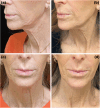Expert Consensus on Clinical Recommendations for Fractional Ablative CO2 Laser, in Facial Skin Rejuvenation Treatment
- PMID: 39434507
- PMCID: PMC11776446
- DOI: 10.1002/lsm.23850
Expert Consensus on Clinical Recommendations for Fractional Ablative CO2 Laser, in Facial Skin Rejuvenation Treatment
Abstract
Background: For three decades, fractional ablative CO2 lasers have been used for skin rejuvenation. With breakthroughs in laser technology and expanding popularity, new recommendations and suggestions arise on a regular basis.
Objective: To develop up-to-date clinical recommendations on safety measures, therapeutic framework, and techniques to improve treatment outcomes.
Methods: Using Google Forms, a questionnaire with 188 questions was given to a varied sample of 21 dermatologists and plastic surgeons from various countries and practice contexts. A second questionnaire with 11 items was created to resolve any gaps or discrepancies.
Results: Active face infections are considered a treatment contraindication by 95% of panelists. Burns, recent sun exposure, and pregnancy or breastfeeding were also considered contraindications (according to 67% of panelists). Over 90% employ bacterial and viral prophylaxis, however the majority (67%) do not prescribe antifungal prophylaxis. The most often stated anesthetic treatments by panelists are topical anesthetic cream, nerve blocks, and oral analgesics (according to 95%, 81%, and 62% of panelists respectively). Over 90% of panel members suggested treatment setting alterations for individuals with Fitzpatrick skin types III-IV. Following reepithelization, which happens between 8 and 42 days after the treatment, the majority (76%) of panelists advocate continuing standard skin care routines including active ingredients. Eighty-one percent of panelists recommend using supplementary treatment to maximize results. Supplementary treatment recommendations included use of neuromodulators (76% of panelists), Intense Pulsed Light Therapy treatments pre and postprocedure (61% of panelists), and injection-based therapies such as (Hyaluronic Acid fillers, and biostimulatory fillers) (recommended by 48% of panelists). 60% of panelists perform FACL to improve skin laxity treatment in nonfacial areas and adjust their settings accordingly.
Limitations: Our results reflect only a modest panel size; with a focus on a specific device. Although experienced, the small number of panelists, recommendations, and personal adverse reactions encounters for resurfacing indication, might be biased.
Conclusion: Fractional CO2 laser is a popular and effective skin rejuvenation treatment with minimal downtime and side effects. This study presents new therapy recommendations to resolve treatment uncertainty and provide complete care suggestions for best results.
Keywords: fractional ablative CO2 laser; laser treatment; postcare; precare; skin rejuvenation; treatment parameters.
© 2024 The Author(s). Lasers in Surgery and Medicine published by Wiley Periodicals LLC.
Conflict of interest statement
Thomas M. Beachkofsky: Works as a clinical trainer and provide consulting services for Lumenis. E. Victor Ross: Past work as a researcher, speaker, and consultant for Lumenis. Kevin Duplechain: Works as a speaker for Lumenis and past honoraria for speaking. Brian S. Biesman: Past research support from Lumenis. Gilly Munavalli: Works with Lumenis as an investigator. Arielle Kauvar: Past research support from Lumenis. Peter Peng: Works as a speaker for Lumenis and past honoraria for speaking. Shangli Lin: Works as a key opinion leader for Lumenis. Jill Waibel: Past work as speaker, advisor and performed paid clinical trials for Lumenis. Matteo T. Clementoni: Works as a consultant of lumenis, received honorarium for travel, workshops, courses, and lectures. Ofir Artzi: Works as a consultant of Lumenis, received honorarium for lectures. Suzanne L. Kilmer: Worked as a consultant for Lumenis. Robert Langdon: Worked as a consultant for Lumenis for developing protocols for single‐pass CO2 laser resurfacing. Daniel P. Friedmann: Works as a consultant, speaker, and performed clinical research for Lumenis. The remaining authors declare no conflicts of interest.
Figures







References
-
- Bonan P. and Verdelli A., “Combined Microwaves and Fractional Microablative CO2 Laser Treatment for Postpartum Abdominal Laxity,” Journal of Cosmetic Dermatology 20, no. 1 (January 2021): 124–131. - PubMed
-
- Woodward J. A., Fabi S. G., Alster T., and Colón‐Acevedo B., “Safety and Efficacy of Combining Microfocused Ultrasound With Fractional CO2 Laser Resurfacing for Lifting and Tightening the Face and Neck,” Dermatologic Surgery 40, no. Suppl 12 (2014): S190–S193. - PubMed
Publication types
MeSH terms
LinkOut - more resources
Full Text Sources
Medical

